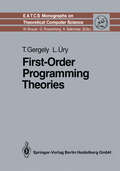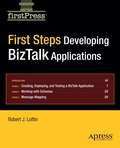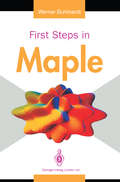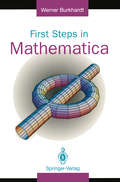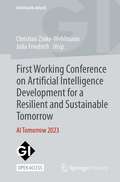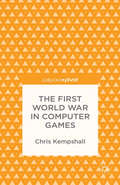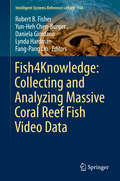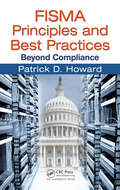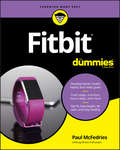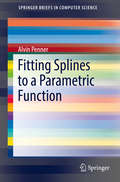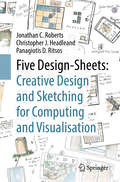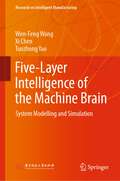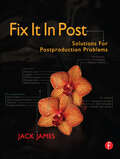- Table View
- List View
A First Introduction to the Finite Element Analysis Program MSC Marc/Mentat
by Andreas Öchsner Marco ÖchsnerThis book offers a brief introduction to the general-purpose finite element program MSC Marc, focusing on providing simple examples, often single-element problems, which can easily be related to the theory that is discussed in finite element lectures. As such, it is an ideal companion book to classical introductory courses on the finite element method. MSC Marc is a specialized program for non-linear problems (implicit solver), which is distributed by the MSC Software Corporation and commonly used in academia and industry. The documentation of all finite element programs now includes a variety of step-by-step examples of differing complexity, and all software companies offer professional workshops on different topics. Since the first edition of the book, there have been several new releases of Marc/Mentat and numerous changes. This new edition incorporates the latest Marc/Mentat software developments and new examples.
First Leaves: A Tutorial Introduction to Maple V
by Bruce W. Char Keith O. Geddes Gaston H. Gonnet Benton L. Leong Michael B. Monagan Stephen M. WattThis tutorial shows how to use Maple both as a calculator with instant access to hundreds of high-level math routines and as a programming language for more demanding tasks. It covers topics such as the basic data types and statements in the Maple language. It explains the differences between numeric computation and symbolic computation and illustrates how both are used in Maple. Extensive "how-to" examples are used throughout the tutorial to show how common types of calculations can be expressed easily in Maple. The manual also uses many graphics examples to illustrate the way in which 2D and 3D graphics can aid in understanding the behavior of functions.
The First Line of Code: Android Programming with Kotlin
by Lin GuoThe First Line of Code is a must-have for developers who want to learn Android and Kotlin, and the best-seller in China. Knowledge between Android and Kotlin is interspersed in a way that readers are easy to understand and get start:· Android part covers all the important aspects of the Android platform, such as activity, service, content provider, broadcast receiver, fragment, basic UI, data storage, network, Jetpack and other application-level knowledge. · Kotlin part covers various aspects of Kotlin, such as standard grammar, common skills, higher-order functions, generics, coroutines, DSL and other language-level knowledge. In addition, The First Line of Code is a very practicing book, illustrating concepts with a complete weather forecast program. You can use and practice all the knowledge comprehensively after learning and see the actual result for what you have learned through the book. All contents of the book are quite easy to understand. It might be a good choice for both beginners and experienced developers. Also suitable for college students, college teachers, etc.
First-order and Stochastic Optimization Methods for Machine Learning (Springer Series in the Data Sciences)
by Guanghui LanThis book covers not only foundational materials but also the most recent progresses made during the past few years on the area of machine learning algorithms. In spite of the intensive research and development in this area, there does not exist a systematic treatment to introduce the fundamental concepts and recent progresses on machine learning algorithms, especially on those based on stochastic optimization methods, randomized algorithms, nonconvex optimization, distributed and online learning, and projection free methods. This book will benefit the broad audience in the area of machine learning, artificial intelligence and mathematical programming community by presenting these recent developments in a tutorial style, starting from the basic building blocks to the most carefully designed and complicated algorithms for machine learning.
First-Order Logic and Automated Theorem Proving (Texts in Computer Science)
by Melvin FittingThere are many kinds of books on formal logic. Some have philosophers as their intended audience, some mathematicians, some computer scien tists. Although there is a common core to all such books, they will be very different in emphasis, methods, and even appearance. This book is intended for computer scientists. But even this is not precise. Within computer science formal logic turns up in a number of areas, from pro gram verification to logic programming to artificial intelligence. This book is intended for computer scientists interested in automated theo rem proving in classical logic. To be more precise yet, it is essentially a theoretical treatment, not a how-to book, although how-to issues are not neglected. This does not mean, of course, that the book will be of no interest to philosophers or mathematicians. It does contain a thorough presentation of formal logic and many proof techniques, and as such it contains all the material one would expect to find in a course in formal logic covering completeness but, not incompleteness issues. The first item to be addressed is, What are we talking about and why are we interested in it? We are primarily talking about truth as used in mathematical discourse, and our interest in it is, or should be, self evident. Truth is a semantic concept, so we begin with models and their properties. These are used to define our subject.
First-Order Logic and Automated Theorem Proving (Monographs in Computer Science)
by Melvin FittingThere are many kinds of books on formal logic. Some have philosophers as their intended audience, some mathematicians, some computer scientists. Although there is a common core to all such books they will be very dif ferent in emphasis, methods, and even appearance. This book is intended for computer scientists. But even this is not precise. Within computer sci ence formal logic turns up in a number of areas, from program verification to logic programming to artificial intelligence. This book is intended for computer scientists interested in automated theorem proving in classical logic. To be more precise yet, it is essentially a theoretical treatment, not a how-to book, although how-to issues are not neglected. This does not mean, of course, that the book will be of no interest to philosophers or mathematicians. It does contain a thorough presentation of formal logic and many proof techniques, and as such it contains all the material one would expect to find in a course in formal logic covering completeness but not incompleteness issues. The first item to be addressed is, what are we talking about and why are we interested in it. We are primarily talking about truth as used in mathematical discourse, and our interest in it is, or should be, self-evident. Truth is a semantic concept, so we begin with models and their properties. These are used to define our subject.
First-Order Programming Theories (Monographs in Theoretical Computer Science. An EATCS Series #24)
by Tamas Gergely Laszlo UryThis work presents a purely classical first-order logical approach to the field of study in theoretical computer science sometimes referred to as the theory of programs, or programming theory. This field essentially attempts to provide a precise mathematical basis for the common activities involved in reasoning about computer programs and programming languages, and it also attempts to find practical applications in the areas of program specification, verification and programming language design. Many different approaches with different mathematical frameworks have been proposed as a basis for programming theory. They differ in the mathe matical machinery they use to define and investigate programs and program properties and they also differ in the concepts they deal with to understand the programming paradigm. Different approaches use different tools and viewpoints to characterize the data environment of programs. Most of the approaches are related to mathe matical logic and they provide their own logic. These logics, however, are very eclectic since they use special entities to reflect a special world of programs, and also, they are usually incomparable with each other. This Babel's mess irritated us and we decided to peel off the eclectic com ponents and try to answer all the questions by using classical first-order logic.
First-stage LISA Data Processing and Gravitational Wave Data Analysis: Ultraprecise Inter-satellite Laser Ranging, Clock Synchronization and Novel Gravitational Wave Data Analysis Algorithms (Springer Theses)
by Yan WangThis thesis covers a diverse set of topics related to space-based gravitational wave detectors such as the Laser Interferometer Space Antenna (LISA). The core of the thesis is devoted to the preprocessing of the interferometric link data for a LISA constellation, specifically developing optimal Kalman filters to reduce arm length noise due to clock noise. The approach is to apply Kalman filters of increasing complexity to make optimal estimates of relevant quantities such as constellation arm length, relative clock drift, and Doppler frequencies based on the available measurement data. Depending on the complexity of the filter and the simulated data, these Kalman filter estimates can provide up to a few orders of magnitude improvement over simpler estimators. While the basic concept of the LISA measurement (Time Delay Interferometry) was worked out some time ago, this work brings a level of rigor to the processing of the constellation-level data products. The thesis concludes with some topics related to the eLISA such as a new class of phenomenological waveforms for extreme mass-ratio inspiral sources (EMRIs, one of the main source for eLISA), an octahedral space-based GW detector that does not require drag-free test masses, and some efficient template-search algorithms for the case of relatively high SNR signals.
First Steps: Developing BizTalk Applications
by Robert LoftinFirst Steps: Developing BizTalk Applications is a primer to most other introductory BizTalk books. If you feel like traditional beginning books are too abstract, and that you are mired in detail and missing the “big picture,” check out this book. It's not a reference—it's a jumpstart to learning BizTalk. You'll learn about the product in a phased approach. This way, you only learn what you need to know, when you need to know it. And the entire book is example-based: you'll learn by doing. Each phase provides detailed instructions for creating, deploying, and testing a BizTalk project. Through the books projects, you will be exposed to orchestrations, pipelines, maps, schemas, messages, ports, shapes, the BizTalk Server Administration console, and the Health and Activity Tracking (HAT) tool. To quickly get ahead and quick–start your BizTalk learning process, this book is for you.
First Steps in Maple
by Werner BurkhardtMaple is a computer algebraic system with a fast-growing number of users in schools, universities, and other institutions. Intended for anyone who is encountering Maple for the first time, First Steps in Maple provides a detailed step-by-step introduction, teaching by way of examples taken from many areas of mathematics. It is particularly suitable for undergraduates, and has self-test problems (with solutions) for each chapter.
First Working Conference on Artificial Intelligence Development for a Resilient and Sustainable Tomorrow: AI Tomorrow 2023 (Informatik aktuell)
by Christian Zinke-Wehlmann Julia FriedrichKünstliche Intelligenz ist ein Treiber der digitalen Transformation von Unternehmen, welche die gesamte Organisation, einschließlich ihrer Strukturen, Prozesse und Mitarbeitender berührt.Die AI Tomorrow Konferenz möchte die menschzentrierte Perspektive auf KI und ihren nachhaltigen Einsatz, im ökologischen wie auch ökonomischen und sozialen Sinne, stärker ins Zentrum des wissenschaftlichen Diskurses rücken.Dies ist ein Open-Access-Buch.Der Inhalt: Die Autor:innen beleuchten Aspekte der KI-Entwicklung und des Einsatzes. Nach einer Einführung zu Resilienz und Nachhaltigkeit von KI erscheinen die Beiträge entsprechend ihrer Zuordnung zu den Konferenzsessions:(I) Digital transformation of organizations or processes through AI(II) Opportunities of AI for society(III) AI supported knowledge management and learning(IV) Manufacturing and factories of the futureDie Zielgruppe: Wissenschaftler:innen und Interessierte aus dem Bereich der Angewandten Informatik
The First World War in Computer Games
by C. KempshallThe First World War in Computer Games analyses the depiction of combat, the landscape of the trenches, and concepts of how the war ended through computer games. This book explores how computer games are at the forefront of new representations of the First World War.
Fish4Knowledge: Collecting And Analyzing Massive Coral Reef Fish Video Data (Intelligent Systems Reference Library #104)
by Robert B. Fisher Yun-Heh Chen-Burger Daniela Giordano Lynda Hardman Fang-Pang LinThis book gives a start-to-finish overview of the whole Fish4Knowledge project, in 18 short chapters, each describing one aspect of the project. The Fish4Knowledge project explored the possibilities of big video data, in this case from undersea video. Recording and analyzing 90 thousand hours of video from ten camera locations, the project gives a 3 year view of fish abundance in several tropical coral reefs off the coast of Taiwan. The research system built a remote recording network, over 100 Tb of storage, supercomputer processing, video target detection and tracking, fish species recognition and analysis, a large SQL database to record the results and an efficient retrieval mechanism. Novel user interface mechanisms were developed to provide easy access for marine ecologists, who wanted to explore the dataset. The book is a useful resource for system builders, as it gives an overview of the many new methods that were created to build the Fish4Knowledge system in a manner that also allows readers to see how all the components fit together.
FISMA and the Risk Management Framework: The New Practice of Federal Cyber Security
by Daniel R. Philpott Stephen D. GantzFISMA and the Risk Management Framework: The New Practice of Federal Cyber Security deals with the Federal Information Security Management Act (FISMA), a law that provides the framework for securing information systems and managing risk associated with information resources in federal government agencies. Comprised of 17 chapters, the book explains the FISMA legislation and its provisions, strengths and limitations, as well as the expectations and obligations of federal agencies subject to FISMA. It also discusses the processes and activities necessary to implement effective information security management following the passage of FISMA, and it describes the National Institute of Standards and Technology's Risk Management Framework. The book looks at how information assurance, risk management, and information systems security is practiced in federal government agencies; the three primary documents that make up the security authorization package: system security plan, security assessment report, and plan of action and milestones; and federal information security-management requirements and initiatives not explicitly covered by FISMA. This book will be helpful to security officers, risk managers, system owners, IT managers, contractors, consultants, service providers, and others involved in securing, managing, or overseeing federal information systems, as well as the mission functions and business processes supported by those systems. - Learn how to build a robust, near real-time risk management system and comply with FISMA - Discover the changes to FISMA compliance and beyond - Gain your systems the authorization they need
FISMA Certification and Accreditation Handbook
by L. Taylor Laura P. TaylorThe only book that instructs IT Managers to adhere to federally mandated certification and accreditation requirements.This book will explain what is meant by Certification and Accreditation and why the process is mandated by federal law. The different Certification and Accreditation laws will be cited and discussed including the three leading types of C&A: NIST, NIAP, and DITSCAP. Next, the book explains how to prepare for, perform, and document a C&A project. The next section to the book illustrates addressing security awareness, end-user rules of behavior, and incident response requirements. Once this phase of the C&A project is complete, the reader will learn to perform the security tests and evaluations, business impact assessments system risk assessments, business risk assessments, contingency plans, business impact assessments, and system security plans. Finally the reader will learn to audit their entire C&A project and correct any failures.* Focuses on federally mandated certification and accreditation requirements* Author Laura Taylor's research on Certification and Accreditation has been used by the FDIC, the FBI, and the Whitehouse* Full of vital information on compliance for both corporate and government IT Managers
FISMA Compliance Handbook: Second Edition
by Laura P. TaylorThis comprehensive book instructs IT managers to adhere to federally mandated compliance requirements. FISMA Compliance Handbook Second Edition explains what the requirements are for FISMA compliance and why FISMA compliance is mandated by federal law. The evolution of Certification and Accreditation is discussed. This book walks the reader through the entire FISMA compliance process and includes guidance on how to manage a FISMA compliance project from start to finish. The book has chapters for all FISMA compliance deliverables and includes information on how to conduct a FISMA compliant security assessment. Various topics discussed in this book include the NIST Risk Management Framework, how to characterize the sensitivity level of your system, contingency plan, system security plan development, security awareness training, privacy impact assessments, security assessments and more. Readers will learn how to obtain an Authority to Operate for an information system and what actions to take in regards to vulnerabilities and audit findings. FISMA Compliance Handbook Second Edition, also includes all-new coverage of federal cloud computing compliance from author Laura Taylor, the federal government's technical lead for FedRAMP, the government program used to assess and authorize cloud products and services. - Includes new information on cloud computing compliance from Laura Taylor, the federal government's technical lead for FedRAMP - Includes coverage for both corporate and government IT managers - Learn how to prepare for, perform, and document FISMA compliance projects - This book is used by various colleges and universities in information security and MBA curriculums
FISMA Principles and Best Practices: Beyond Compliance
by Patrick D. HowardWhile many agencies struggle to comply with Federal Information Security Management Act (FISMA) regulations, those that have embraced its requirements have found that their comprehensive and flexible nature provides a sound security risk management framework for the implementation of essential system security controls. Detailing a proven appro
FISMA Principles and Best Practices: Beyond Compliance
by Patrick D. HowardWhile many agencies struggle to comply with Federal Information Security Management Act (FISMA) regulations, those that have embraced its requirements have found that their comprehensive and flexible nature provides a sound security risk management framework for the implementation of essential system security controls. Detailing a proven appro
Fitbit For Dummies
by Paul McFedriesTake a complete tour of the Fitbit ecosystem From Fitbit features to the Fitbit app to the social features of Fitbit.com, this approachable book covers everything you need to know to get the most out of your Fitbit wristband or watch. Whether you’re a fitness newcomer, a regular walker, or a long-time exerciser, your Fitbit is a powerful device that can tell you much more than how many steps you take each day. This book offers easy-to-follow, step-by-step instructions for tracking all that data and getting the most out of your Fitbit investment. Go beyond steps to track sleep, heart rate, weight, and more Set up your health and fitness goals — then go for them! Connect to third-party apps such as Strava and Weight Watchers Stay motivated by sharing your activities with friends It’s one thing to simply wear your Fitbit, but it’s quite another to use your Fitbit to reach your personal health goals. Whether that goal is to get fit, lose weight, eat better, or reduce stress, your Fitbit has settings and features that can help you get there. And this book shows you how!
Fitbit For Dummies
by Paul McFedriesTake a complete tour of the Fitbit ecosystem From Fitbit features to the Fitbit app to the social features of Fitbit.com, this approachable book covers everything you need to know to get the most out of your Fitbit wristband or watch. Whether you’re a fitness newcomer, a regular walker, or a long-time exerciser, your Fitbit is a powerful device that can tell you much more than how many steps you take each day. This book offers easy-to-follow, step-by-step instructions for tracking all that data and getting the most out of your Fitbit investment. Go beyond steps to track sleep, heart rate, weight, and more Set up your health and fitness goals — then go for them! Connect to third-party apps such as Strava and Weight Watchers Stay motivated by sharing your activities with friends It’s one thing to simply wear your Fitbit, but it’s quite another to use your Fitbit to reach your personal health goals. Whether that goal is to get fit, lose weight, eat better, or reduce stress, your Fitbit has settings and features that can help you get there. And this book shows you how!
Fitting Splines to a Parametric Function (SpringerBriefs in Computer Science)
by Alvin PennerThis Brief investigates the intersections that occur between three different areas of study that normally would not touch each other: ODF, spline theory, and topology.The Least Squares Orthogonal Distance Fitting (ODF) method has become the standard technique used to develop mathematical models of the physical shapes of objects, due to the fact that it produces a fitted result that is invariant with respect to the size and orientation of the object. It is normally used to produce a single optimum fit to a specific object; this work focuses instead on the issue of whether the fit responds continuously as the shape of the object changes. The theory of splines develops user-friendly ways of manipulating six different splines to fit the shape of a simple family of epiTrochoid curves: two types of Bézier curve, two uniform B-splines, and two Beta-splines. This work will focus on issues that arise when mathematically optimizing the fit. There are typically multiple solutions to the ODF method, and the number of solutions can often change as the object changes shape, so two topological questions immediately arise: are there rules that can be applied concerning the relative number of local minima and saddle points, and are there different mechanisms available by which solutions can either merge and disappear, or cross over each other and interchange roles. The author proposes some simple rules which can be used to determine if a given set of solutions is internally consistent in the sense that it has the appropriate number of each type of solution.
Five Design-Sheets: Creative Design And Sketching For Computing And Visualisation
by Jonathan C. Roberts Christopher J. Headleand Panagiotis D. RitsosThis book describes a structured sketching methodology to help you create alternative design ideas and sketch them on paper. The Five Design-Sheet method acts as a check-list of tasks, to help you think through the problem, create new ideas and to reflect upon the suitability of each idea. To complement the FdS method, we present practical sketching techniques, discuss problem solving, consider professional and ethical issues of designing interfaces, and work through many examples.Five Design-Sheets: Creative Design and Sketching for Computing and Visualization is useful for designers of computer interfaces, or researchers needing to explore alternative solutions in any field. It is written for anyone who is studying on a computing course and needs to design a computing-interface or create a well-structured design chapter for their dissertation, for example. We do acknowledge that throughout this book we focus on the creation of interactive software tools, and use the case study of building data-visualization tools. We have however, tried to keep the techniques general enough such that it is beneficial for a wide range of people, with different challenges and different situations, and for different applications.
Five-Layer Intelligence of the Machine Brain: System Modelling and Simulation (Research on Intelligent Manufacturing)
by Wen-Feng Wang Xi Chen Tuozhong YaoThis book intends to report the new results of the efforts on the study of Layered Intelligence of the Machine Brain (LIMB). The book collects novel research ideas in LIMB and summarizes the current machine intelligence level as “five layer intelligence”- environments sensing, active learning, cognitive computing, intelligent decision making and automatized execution. The book is likely to be of interest to university researchers, R&D engineers and graduate students in computer science and electronics who wish to learn the core principles, methods, algorithms, and applications of LIMB.
Fix It In Post: Solutions for Postproduction Problems
by Jack JamesThis book provides an array of concise solutions to the wide variety of problems that are faced by postproduction artists in the post process. With an application-agnostic approach, it gives proven, step-by-step methods to solving the most frequently encountered postproduction problems. Also included is access to a free, password-protected website that features application-specific resolutions to the problems presented, with fixes for working in Apple's Final Cut Studio suite, Avid's Media Composer, Adobe Premiere Pro, as well as other applications. Lessons are enhanced through eye-catching 4 color illustrations throughout. Solutions are provided for common audio, video, digital, editorial, color, timing and compositing problems, such as, but not limited to:* automated dialogue replacement, adjusting sync, and correcting pitch * turning SD into HD (and vice-versa) and restoration of old film for video* removing duplicate frames, repairing corrupt frames, and anti-aliasing * maintaining continuity, removing soft cuts, and troubleshooting timecodes* adding vignettes, removing color casts, and legalizing color* speeding shots up or slowing shots down, and smoothing timelapse* reframing shots, sky replacement, and object addition or removalThe book is presented in a "cookbook" format, allowing you to reference your exact problem in the TOC or index, go to that section, and immediately implement the solution featured.






